Τελικά ο William Morris έβλεπε στο μέλλον;
DS.WRITER:
Christina Ioakeimidou
Πηγή Κεντρικής εικόνας: https://julia-writes.com/2021/06/07/the-century-guild-at-william-morris-gallery/
«Have nothing in your houses that you do not know to be useful or believe to be beautiful.» Αυτή η φράση του William Morris εμπεριέχει ίσως ολόκληρη τη φιλοσοφία του Άγγλου σχεδιαστή. Ήταν όμως ο Morris απλώς σχεδιαστής; Η απάντηση είναι πως όχι, δεν ήταν. Τα ενδιαφέροντά του εστίαζαν όχι μόνο στον σχεδιασμό επίπλων, ταπετσαριών καθώς και άλλων αντικειμένων, αλλά ο ίδιος ανέπτυξε επίσης έντονο θεωρητικό έργο. Αντιτιθέμενος στις νόρμες της Βικτωριανής εποχής, ο Morris πολιτικά και ιδεολογικά διαφοροποιήθηκε αρκετά από την υπάρχουσα στροφή προς την ανάπτυξη της βιομηχανίας.
Από το Oxford movement στον J. Ruskin
Ο W. Morris γεννήθηκε στο Walthamstow του ανατολικού Λονδίνου το 1834, στις αρχές δηλαδή της Βικτωριανής εποχής. Ως μέλος μιας αρκετά ευκατάστατης, για την εποχή, οικογένειας, η ζωή του νεαρού είχε τις καλύτερες προδιαγραφές. Περνώντας σχεδόν όλη την παιδική του ηλικία στο Woodford Hall του Essex, είχε τη δυνατότητα να περιπλανάται στην εξοχή, να περνάει χρόνο στη φύση, κοντά σε εκκλησίες της αγγλικής εξοχής. Επιπλέον, ανέπτυξε ιδιαίτερο ενδιαφέρον για την ποίηση και τη λογοτεχνία, μελετώντας το έργο τού διάσημου συγγραφέα Walter Scott. Ίσως και αυτή η μελέτη στάθηκε η αφορμή για τη διαμόρφωση του χαρακτήρα του και την αγάπη του για τον ιστορικό Ρομαντισμό και την αναπόληση παλαιότερων εποχών. Μάλιστα, η αντιπάθειά του για την αναπτυσσόμενη βιομηχανική δραστηριότητα φάνηκε από τα εφηβικά του χρόνια, όταν, το 1851, αρνήθηκε να επισκεφθεί την Great Exhibition του Λονδίνου, μένοντας πιστός στην άποψή του, ότι η χειρονακτική κατασκευή των προϊόντων θα πρέπει να είναι η βασική προτεραιότητα του κατασκευαστικού και καλλιτεχνικού κλάδου.
Λίγα χρόνια αργότερα, ξεκινά τις σπουδές του στο πανεπιστήμιο της Οξφόρδης. Εκεί, γνωρίζει τον μετέπειτα γνωστό ζωγράφο Burne-Jones, με τον οποίο θα αναπτύξει μία μακροχρόνια φιλία. Μαζί θα γίνουν μέρος του The Brotherhood, ενός γκρουπ όπου οι ιστορίες Ιπποσύνης, Ρομαντισμού και αυτοθυσίας διηγούνται σε σχεδόν καθημερινή βάση, ενώ οι δυο τους επηρεάστηκαν και από το Oxford movement, ένα κίνημα που έθετε ως προτεραιότητά του την αναβίωση του Καθολικισμού μέσα στους κύκλους της Αγγλικανικής Εκκλησίας. Όμως, κάπου εδώ φαίνεται ότι κάτι αλλάζει αμυδρά στη σκέψη τού Morris, χάρη στην επαφή του με τα κείμενα των σύγχρονών του μεταρρυθμιστών, και κυρίως με το έργο του John Ruskin.
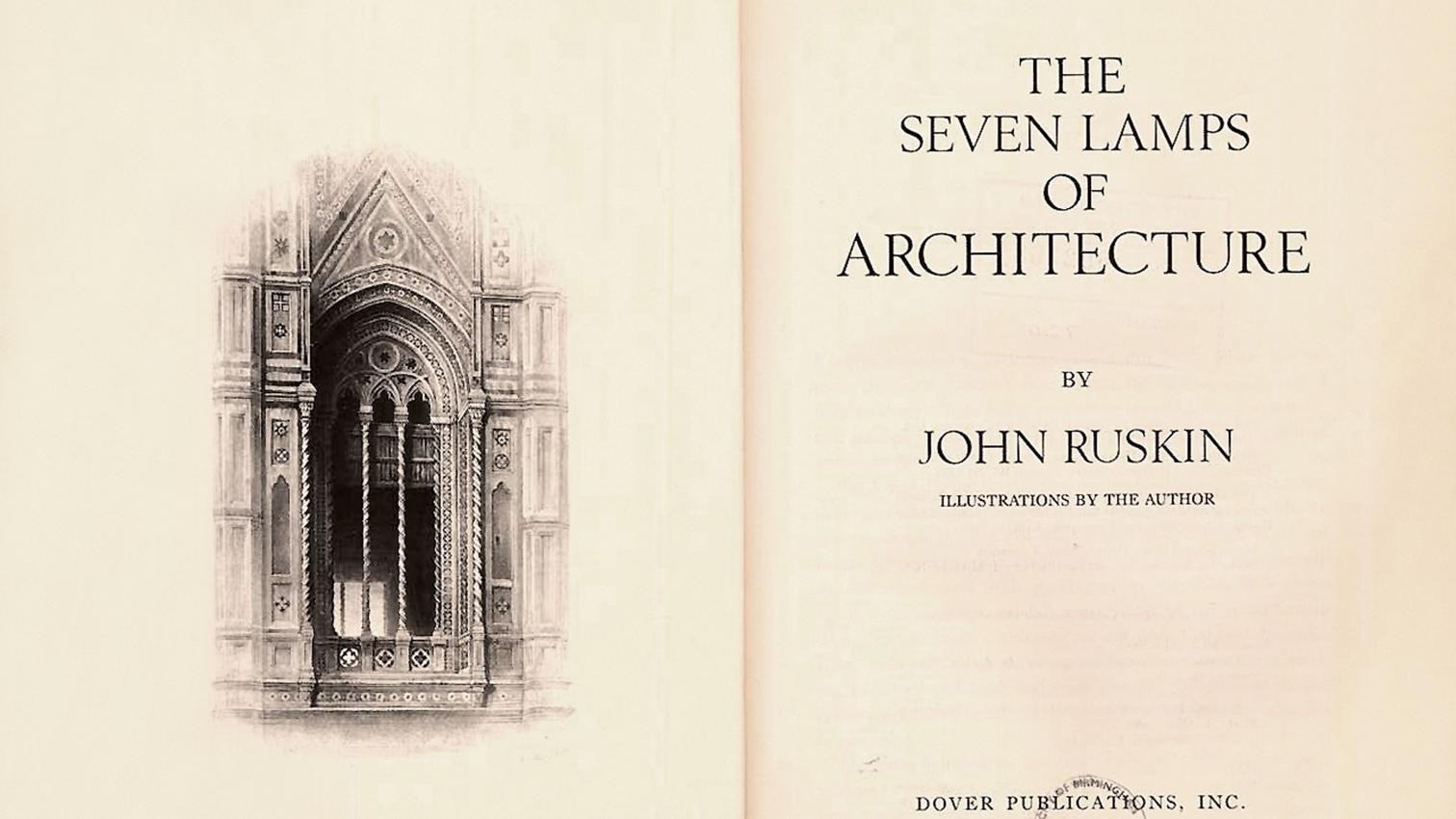
Πηγή εικόνας: https://arquitecturaviva.com/articles/seven-lamps
Η άκρως αντιμοντέρνα θεωρητική προσέγγιση του Ruskin επηρέασε τον Morris, ο οποίος άφησε πίσω του τον ονειρικό αισθητικό μεσαιωνισμό. Τώρα ήταν ένας από τους πιο φανατικούς αντι-βικτωριανιστές. Δεν είναι τυχαίο άλλωστε το γεγονός πως, μετά το τέλος των σπουδών του, το 1856, ξεκίνησε να εργάζεται στο αρχιτεκτονικό γραφείο του G.E. Street, αναβιωτή του γοτθικού στοιχείου στη βικτωριανή αρχιτεκτονική. Μαζί με τον Street και τον Burne-Jones, επισκέφθηκαν το Βέλγιο και περιοχές της βόρειας Γαλλίας. Τότε ο Morris θα έρθει σε επαφή με το έργο των Hans Memling, Jan και Hubert Van Eyck, ενώ τότε θα γνωρίσει καλύτερα τη γοτθική αρχιτεκτονική.
Γυρνώντας πίσω, πείθεται από τον Dante Gabriel Rossetti να συμμετάσχει στη ζωγραφική επιτοίχια διακόσμηση του Oxford Union, με σκηνές παρμένες από τον μύθο του Αρθούρου. Το μοναδικό σωζόμενο μέρος που αποδίδεται στον Morris, είναι το La Belle Iseult (1858).
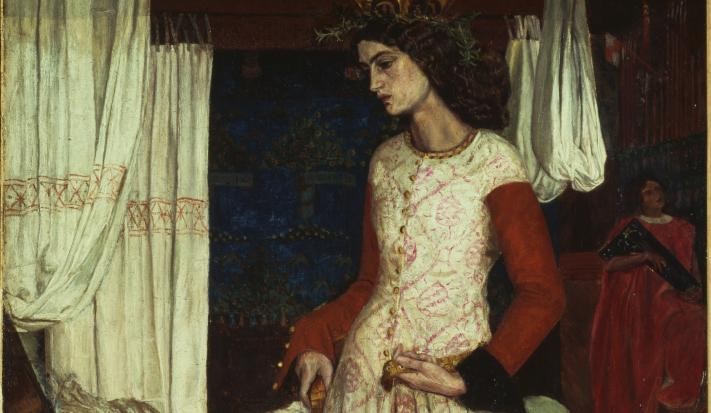
Μέρος του La Belle Iseult στο Oxford Union | Πηγή εικόνας: https://www.culturewhisper.com/r/visual_arts/preview/1993
Από αυτή τη στιγμή και έπειτα, η αρχιτεκτονική θα αποτελέσει παρελθόν για τον William Morris, ο οποίος θα επικεντρωθεί στη ζωγραφική και το design αντικειμένων.
Πρώτα η ποιότητα και μετά η ποσότητα
Πλέκοντας τον αντιμοντερνισμό με τη θεωρία που αναπτύχθηκε από τον Κ. Μαρξ, ο Morris αρχίζει να χτίζει τη δική του θεωρητική προσέγγιση και απομακρύνεται σταδιακά από τον ελιτισμό του «δασκάλου» του, J. Ruskin. Για τον ίδιο, σημαντικός παράγοντας στην εργασία των εργατών ήταν η αίσθηση χαράς και ευχαρίστησης, που θα μπορούσε να επιτευχθεί μέσω της συνεργασίας όλων των τομέων. Αυτή η άποψη, επιπλέον, τον διαχώρισε από άλλες πολιτικές ομάδες της εποχής, όπως τους Fabians, αφού ο ίδιος επέκρινε τον τρόπο προσέγγισης του γραφειοκρατικά σοσιαλιστικού κράτους, το οποίο ποτέ, κατά τον ίδιο, δεν έθετε ως προϋπόθεση την ανθρωπιστική διάσταση της σύγχρονης κοινωνίας.
Την ίδια ακριβώς οπτική προσπάθησε να δώσει και στην καλλιτεχνική του ενασχόληση. Κεντρικός πυλώνας της ιδεολογίας και προσέγγισης του Morris ήταν η επικέντρωση στην ποιότητα των παραγόμενων αντικειμένων, μια ποιότητα που τα βιομηχανικά αντικείμενα, κατά τον ίδιο, στερούνταν. Ο ίδιος έγραψε το 1894: «Apart from the desire to produce beautiful things, the leading passion of my life has been and is the hatred of modern civilization». Έτσι, στη δουλειά του η ομορφιά, η ποιότητα και η πρακτικότητα του εκάστοτε αντικειμένου ήταν το τρίπτυχο που θα τον οδηγήσει στην ίδρυση του Morris, Marshall, Faulkner & Co. (ή "Fine Art Workmen in Painting, Carving, Furniture and the Metals") (1861-1875), μιας εταιρείας που επικεντρωνόταν στην κατασκευή χειροποίητων, οικιακών αντικειμένων. Μαζί με τους Ford Madox Brown, Edward Burne-Jones, Charles Faulkner, Dante Gabriel Rossetti, P. P. Marshall και Philip Webb, ανέλαβαν τον σχεδιασμό αντικειμένων μεταλλοτεχνίας, βιτρό, χαλιών, τυπωμένων υφασμάτων (chintzes), καθώς και των περίφημων ταπετσαριών με ελικοειδή φυτικά μοτίβα.
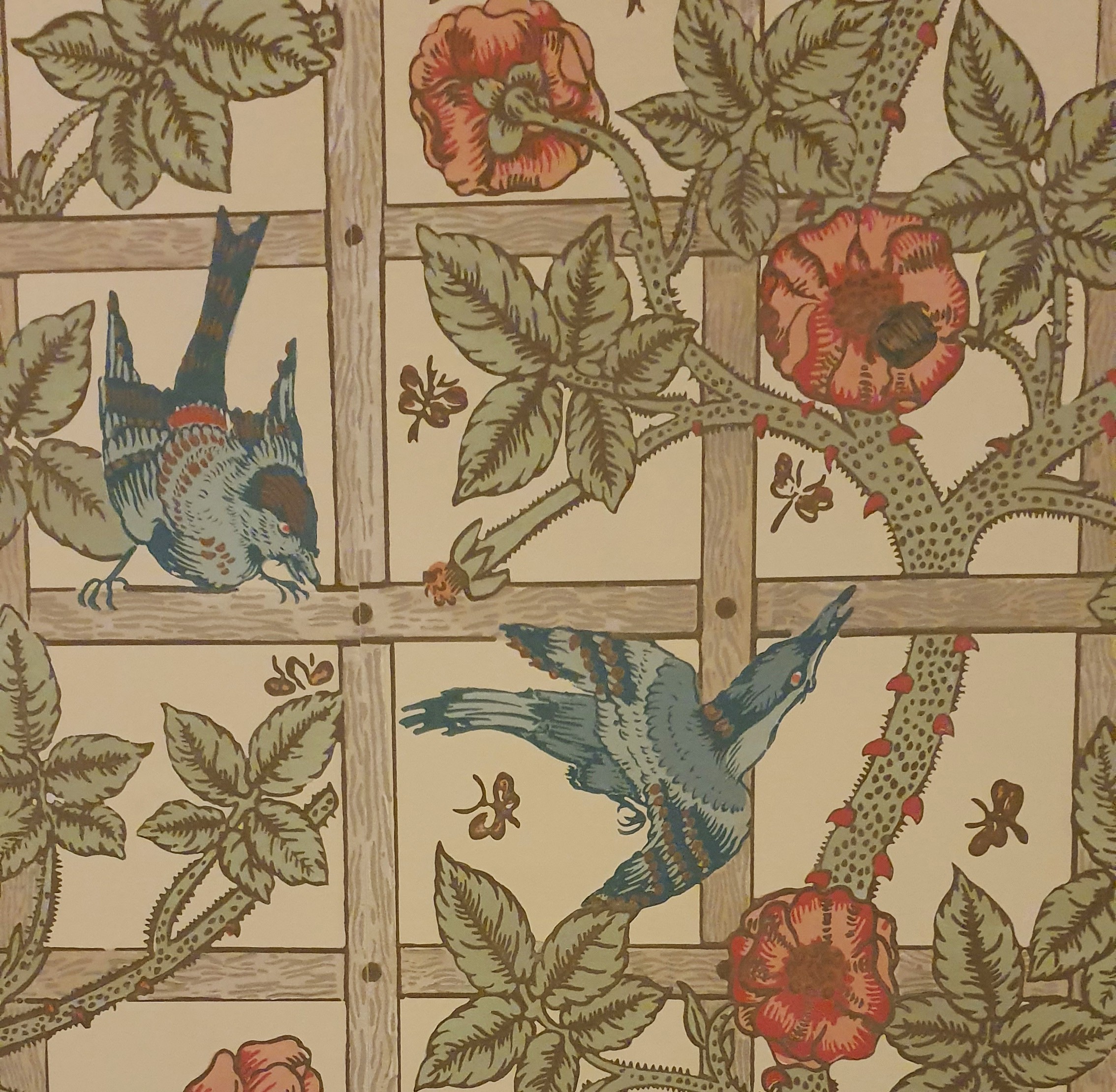
Πηγή εικόνας: https://pbs.twimg.com/media/ET3dg0uXgAAL8lx?format=jpg&name=4096x4096
Η επιμονή του Morris και των συνεργατών του οδήγησε στη γέννηση του κινήματος Arts and Crafts, το 1860, επηρεάζοντας πολλούς ακόμα καλλιτέχνες, θεωρητικούς και κινήματα, όπως αυτό της Χορτοφαγίας (Vegetarianism). Ωστόσο, μολονότι ο ίδιος πίστευε στις αξίες μιας σοσιαλιστικής κοινωνίας και αποστρεφόταν τη βιομηχανική κατανάλωση φθηνών προϊόντων, η πλειοψηφία των πελατών του ήταν ευκατάστατοι αστοί. Φυσικά, το ερώτημα που προκύπτει είναι πώς ένας φανατικός αντίπαλος της Βιομηχανικής Επανάστασης και των δεινών που αυτή έφερε σε καλλιτεχνικό και επαγγελματικό επίπεδο, απευθυνόταν στους κατόχους του «κεφαλαίου».
Η απάντηση βρίσκεται στην ίδια τη διαδικασία παραγωγής αυτών των αντικειμένων. Προφανώς, για παράδειγμα, τα χειροποίητα και περίτεχνα διακοσμημένα υφάσματα θα ήταν ακριβότερα από αυτά της μαζικής παραγωγής, και άρα καθόλου προσιτά σε όλους. Έτσι, όσο ελπιδοφόρα -θα λέγαμε ως και περιβαλλοντικά ορθή- ακουγόταν η ιδέα του περί σημαντικότητας της ποιότητας, της ομορφιάς και της πρακτικότητας των πάσης φύσεως αντικειμένων καθημερινής χρήσης, δεν φαίνεται η εφαρμογή της να ήταν πολύ εύκολη.
Παρόλα αυτά, βασική επιθυμία του Morris ήταν να επιφέρει την αλλαγή στη ζωή των ανθρώπων, προσφέροντάς τους τη δυνατότητα να αγοράζουν λιγότερα αντικείμενα, τα οποία όμως θα χαρακτηρίζονται από την ποιότητα και τη διαχρονικότητά τους. Ίσως αυτό να συνδέεται και με την ανησυχία του για την αλλοίωση του περιβάλλοντος από την εκτεταμένη βιομηχανική δραστηριότητα, μία αλλοίωση που σήμερα είναι περισσότερο εμφανής από ποτέ. Ενδεχομένως, λοιπόν, ο ίδιος να ήταν περισσότερο υπέρμαχος της οικολογίας και των αρχών της βιωσιμότητας, τουλάχιστον όπως οι έννοιες αυτές είναι αντιληπτές σήμερα.
Μπορεί να θεωρηθεί ένα κόκκινο, μεσαιωνικού τύπου σπίτι, πρωτοποριακό;
Το 1859, ο Morris αναθέτει στον Phillip Webb την κατασκευή ενός σπιτιού στο Bexleyheath του νοτιοανατολικού Λονδίνου. Το κτίσμα δεν θα ήταν μόνο ο χώρος κατοικίας του ίδιου και της συζύγου του, αλλά θα αποτελούσε χώρο συνάντησης και εργασίας όλων των συνεργατών και φίλων του. Φυσικά, αφού το σπίτι ήταν προϊόν του κύκλου του Άγγλου designer, δεν θα μπορούσε να μην ακολουθεί τα πρότυπα του μεσαιωνικού ύφους, με στοιχεία του Ρομαντισμού στη διακόσμηση του εσωτερικού του. Το σπίτι που περιγράφεται από τον D. G. Rossetti ως «…more a poem than a house…», είναι αρκετά επιβλητικό εξωτερικά με αετωματικές στέγες, ενώ εσωτερικά είναι σχεδόν ολόκληρο καλυμμένο με επιτοίχια φυτική διακόσμηση, επιμελημένη από τον ίδιο και τους Edward Burne-Jones και Dante Gabriel Rossetti.
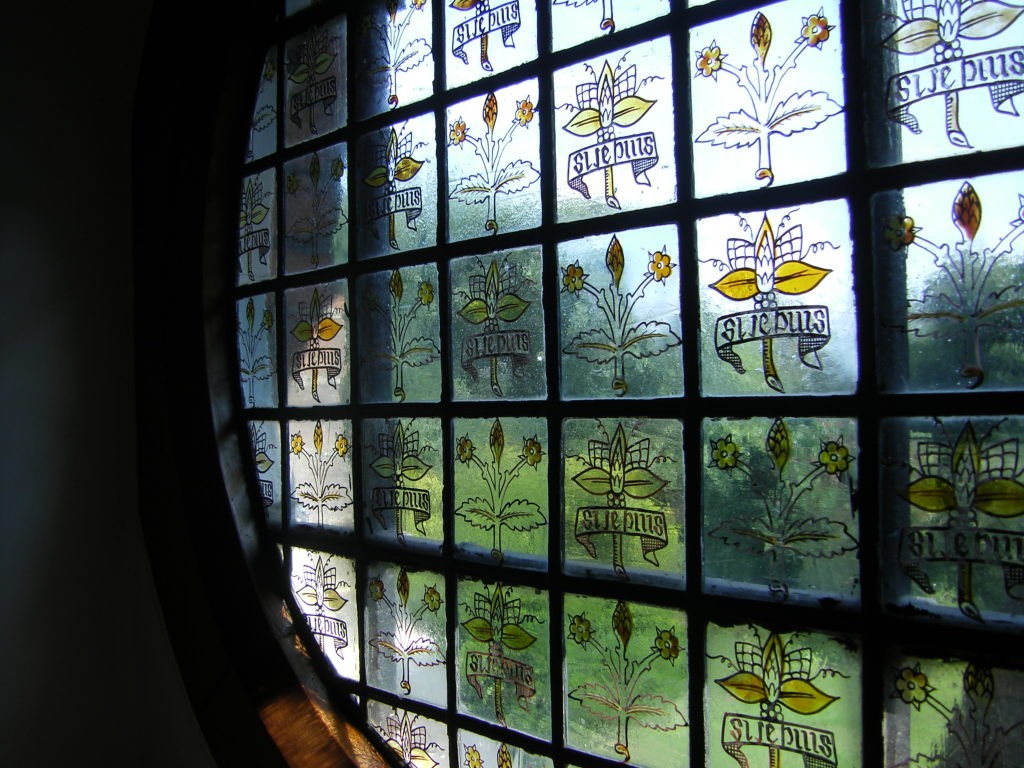
Βιτρό από το Red House στο Bexleyheath (1859-1860) | Πηγή εικόνας: https://www.tiovivocreativo.com/blog/arquitectura/william-morris-y-el-arts-and-crafts/
Την όλη εμπειρία της διακόσμησης του σπιτιού συμπληρώνει η βαριά επίπλωση, επιτείνοντας την ιδέα του Cult of Domesticity, βάσει της οποίας το σπίτι είναι το μέρος απόλαυσης και ξεκούρασης από το χάος των πόλεων.
Το Red House, όμως, δεν ήταν μόνο μέρος κατοικίας που συμπεριελάμβανε και εργαστήριο. Ήταν ένα σύμβολο του τρόπου λειτουργίας του Morris και τον υπόλοιπων μελών τού κινήματος Arts and Crafts. Στόχευε στην ανάπτυξη μιας μορφής συντεχνίας, όπου όλοι οι καλλιτεχνικοί κλάδοι θα συνεργάζονταν με σκοπό την ολοκληρωμένη παραγωγή ποιοτικών αντικειμένων κάθε είδους. Ήταν ένα «guild», δηλαδή, στα πρότυπα των μεσαιωνικών εργαστηρίων.
Πώς όμως ο William Morris και το Arts and Crafts επηρέασε, και ίσως συνεχίζει να επηρεάζει, τον χώρο της αρχιτεκτονικής και του design αισθητικά και θεωρητικά;
Από τη Μ. Βρετανία, στη Γερμανία και το σήμερα
Η αποστροφή προς τη βιομηχανική ανάπτυξη δεν έμεινε μόνο στη Μ. Βρετανία, αλλά έφτασε να χαρακτηρίζει την καλλιτεχνική έκφραση του δυτικού κόσμου. Κυρίως τα αναπτυσσόμενα βιομηχανικά κέντρα, όπως οι Η.Π.Α και η Γερμανία, άρχισαν να προβάλουν, στην αρχή συγκρατημένα και μετέπειτα σθεναρά, την αντίθεσή τους απέναντι στα μαζικά παραγόμενα προϊόντα. Εντούτοις, η αντιμετώπιση και ο τρόπος έκφρασης αυτής της πόλωσης διαφέρουν αρκετά. Χαρακτηριστικό παράδειγμα αυτής της διαφοροποίησης είναι η τροπή που πήρε το Arts and Crafts στις Η.Π.Α, όπου η υποκειμενική αμφιθυμία των ηγετών του κινήματος -με πρωτοπόρο τον Charles Eliot Norton- στάθηκε εμπόδιο για τη διαμόρφωση μιας ξεκάθαρης στάσης απέναντι στα θεωρητικά και πρακτικά προβλήματα που τίθενται από τους Βρετανούς ομολόγους τους. Έτσι, έχοντας ως βάση τις αρχές τής βρετανικής πλευράς του κινήματος, άρχισαν να αναπτύσσονται κοινότητες, ανάμεσα σε αυτές και η Boston Society of Arts and Crafts. Με ιδρυτή της τον ίδιο τον C. E. Norton, η κοινότητα ανέφερε πως σκοπός της ήταν η δημιουργία «costly but precious products, with something of human life in them», ιδέα που συναντάμε αρχικά στη Μ. Βρετανία.
Τομή για την έκφραση της αμερικανικής τάσης του κινήματος, ήταν η δουλειά τού Gustav Stickley. Πολυσχιδής, όπως ο Morris, ο Stickley ασχολείται με όλους τους κλάδους της χειροτεχνίας, ενώ τα έπιπλά του -άκαμπτα και βαριά, αλλά χωρίς να χάνουν την ομορφιά και την πρακτικότητά τους- θυμίζουν τα βρετανικά αντίστοιχά τους, με εξαίρεση την παντελή απουσία διακόσμησης.
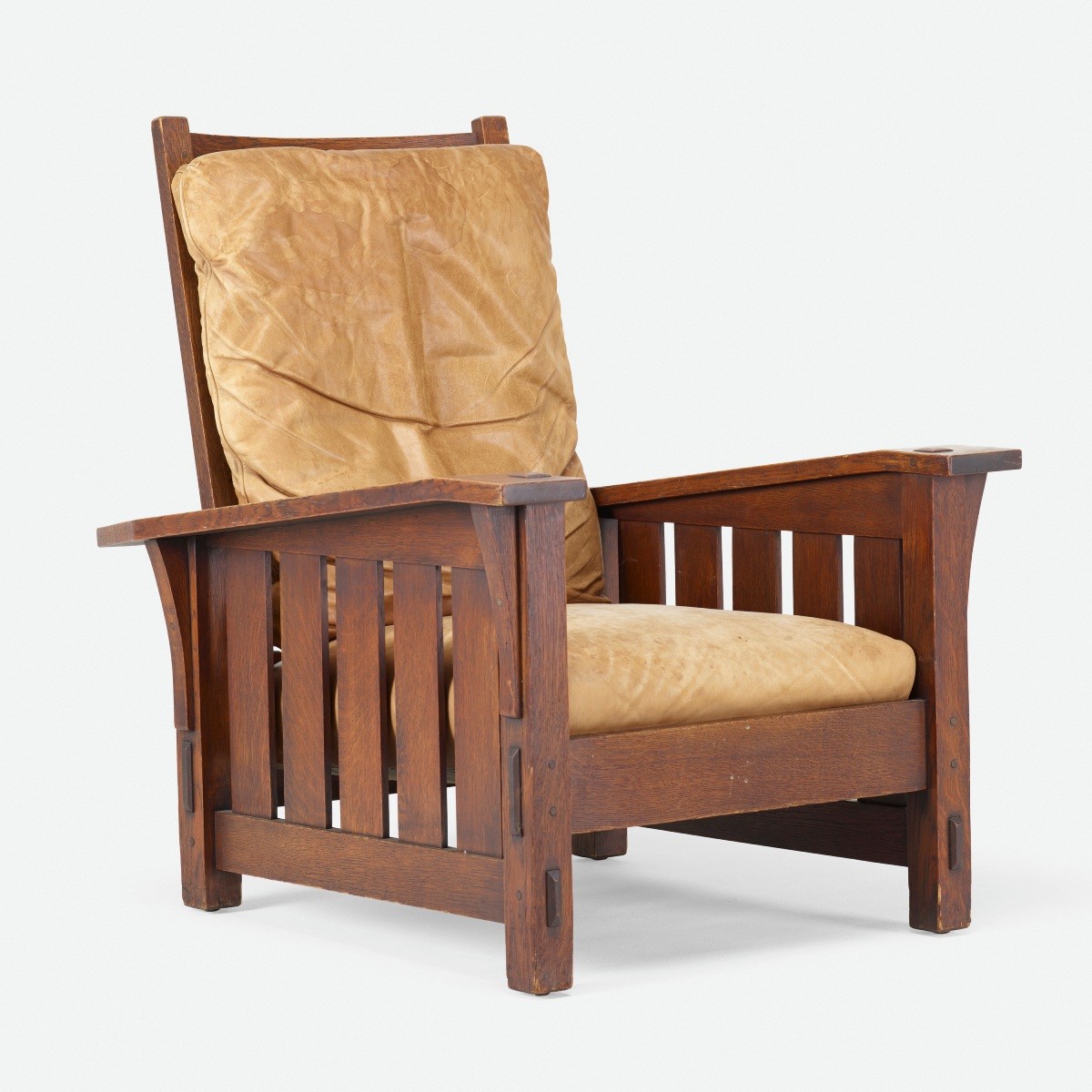
‘’Drop-arm Morris chair’’ (περ. 1905-1912) | Πηγή εικόνας: https://www.ragoarts.com/auctions/2020/09/early-20th-century-design/300
Αντίστοιχες θέσεις περί ανάγκης απελευθέρωσης των τεχνών και της καλλιτεχνικής δημιουργίας από την τυποποίηση της βιομηχανικής παραγωγής, εμφανίζονται και στη Γερμανία. Αυτές τουλάχιστον ήταν οι θέσεις του Van de Velde, ενός εκ των δύο κύριων εκπροσώπων της Deutscher Werkbund. Όμως, με το πέρασμα του χρόνου και τη συνεργασία του Peter Behrens -ιδρυτικού μέλους της συντεχνίας- με την AEG, η αποστασιοποίηση από τον βιομηχανικό σχεδιασμό ελαττώνεται, χωρίς ωστόσο να χάνεται ο κολεκτιβισμός των τεχνών, με το σύνθημα «Vom Sofakissen zum Städtebau» της γερμανικής συντεχνίας να είναι κυρίαρχο. Άλλωστε, και η μετέπειτα εξέλιξή της, αυτή τη φορά με κεντρική μορφή τον Walter Gropius, διέτεινε την ενότητα όλων των καλλιτεχνών κάτω από μία στέγη. Τη σχολή Bauhaus. Αυτή τη φορά, όμως, τα αντικείμενα παράγονται από τα εργαστήρια της σχολής, σε μεγαλύτερες ποσότητες αλλά όχι μαζικά, έχοντας ως κύρια επικέντρωση την εξέλιξη και χρήση της σύγχρονης τεχνολογίας, πρακτική εκ διαμέτρου αντίθετη με τις προκηρύξεις του βρετανικού Arts and Crafts.
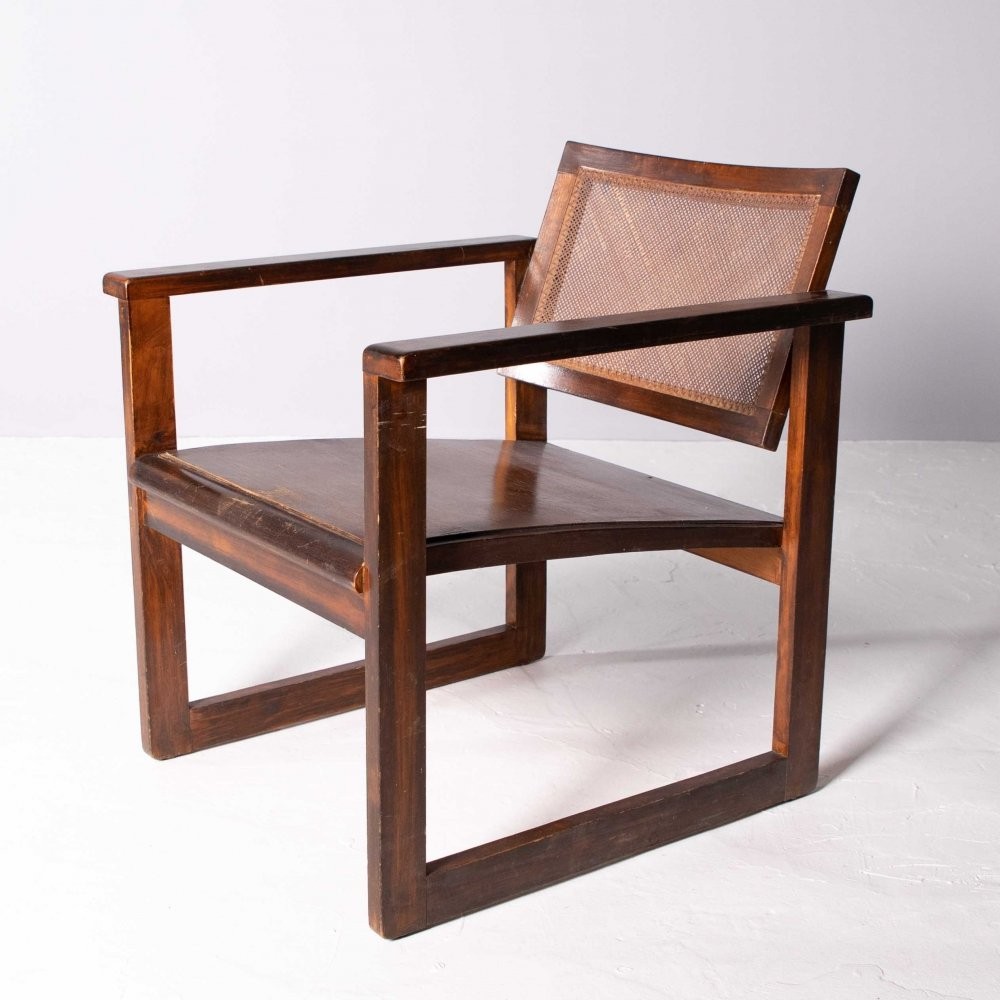
Bauhaus armchair (Peter Keler, περ. 1920) | Πηγή εικόνας: https://www.vntg.com/139899/bauhaus-armchair-by-peter-keler-1920s/
Στόχος των καλλιτεχνών, τώρα, είναι η λιτότητα και η πρακτικότητα των προϊόντων και η απομάκρυνση από την αισθητική, τη χειροτεχνική εργασία και τη χρήση περισσότερο φυσικών υλικών, που διέτεινε ο Morris και οι συνεργάτες του. Ο λόγος, ωστόσο, αυτής της απομάκρυνσης έγκειται και στις ιδιαίτερες γενικότερες κοινωνικοπολιτικές συνθήκες της εποχής, και στην αλλαγή που φαίνεται να επέρχεται στην κοινωνία -άρα και στον καλλιτεχνικό χώρο-, η οποία βρίσκεται στο μεταίχμιο δύο καταστροφικών πολέμων και του κινδύνου πολλών εμφυλίων.

Wassily chair | Πηγή εικόνας: https://www.1stdibs.com/en-gb/buy/original-wassily-chair/
Μήπως τελικά οι απόψεις και η εμμονή του Morris στην ανάγκη ύπαρξης καλλιτεχνικών συντεχνιών, οι οποίες θα είναι ικανές να δημιουργούν ποιοτικά και διαχρονικά αντικείμενα, είναι η λύση που αναζητάμε τώρα; Με την κυριαρχία των παντός είδους μαζικά παραγόμενων προϊόντων, που είναι πράγματι προσβάσιμα για όλους αλλά δεν αντεπεξέρχονται στα ποιοτικά στάνταρντς του καταναλωτή, η ύπαρξη μικρότερων, τοπικού χαρακτήρα βιοτεχνιών έχει εκλείψει. Η ανυπαρξία αυτών των μικρών βιομηχανιών, που κατά κάποιον τρόπο ακολουθούν το μοτίβο της συντεχνίας (σχεδιασμός, κατασκευή, παραγωγή και πώληση των προϊόντων), είναι φυσικό να στερήσει από την αγορά ένα σημαντικό μέρος. Τα αντικείμενα μεσαίας τιμής, και άρα προσβάσιμα για όλους, που δεν θα στερούνται ποιότητας ούτε καλαισθησίας, αν συγκριθούν με τα αντίστοιχα των high-end ή “fast fashion” εταιρειών, είναι η λύση που αναζητούμε για ένα περισσότερο ευνοϊκό μέλλον στον τομέα του design. Όπως φάνηκε, αυτή η λύση είχε βρεθεί για λίγο με τις προτάσεις του Bauhaus, αλλά μετά χάθηκε. Ήρθε η ώρα, λοιπόν, να ξαναγυρίσουμε στην άμεση σχέση που θα πρέπει να έχει η ποιότητα των παραγόμενων προϊόντων με την τιμή πώλησής τους, έτσι ώστε αυτά να είναι προσιτά για όλους.
Πηγές/ Further reading
Introducing William Morris. Από: https://www.vam.ac.uk/articles/introducing-william-morris.
William Morris textiles. Από: https://www.vam.ac.uk/articles/willam-morris-textiles.
L. Fiederer. AD Classics: Red House / William Morris and Philip Webb. Από: https://www.archdaily.com/873077/ad-classics-red-house-arts-crafts-william-morris-philip-webb.
Arts and Crafts Movement. Από: https://exhibitions.lib.umd.edu/williammorris/morris-influence/arts-and-crafts-movement.
S. Sporn (2021). Was William Morris the Forefather of Grandmillennial Style? These Morris & Co. Patterns Make the Case. Από: https://www.architecturaldigest.com/story/160-years-of-morris-and-co-in-8-fabrics-wallpapers-and-tapestries.
Craftsman Farms in the Stickley Era. Από: https://www.stickleymuseum.org/history/.
William Morris: Useful Beauty in the Home | HENI Talks. Από: https://www.youtube.com/watch?v=sjdCOUGrNK8&ab_channel=HENITalks.
A. Watson (2019). The first eco-warrior of design. https://www.bbc.com/culture/article/20190909-the-first-eco-warrior-of-design.
B. Colomina, & M. Wigley. Are we human?: notes on an archaeology of design. (Lars Müller Publishers).
T.J.J. Lears, No place of grace: antimodernism and the transformation of American culture, 1880-1920, (New York: Pantheon Books, 1981).
U. Conrads (ed.), Programs and Manifestoes on 20th Century Architecture. (London: Lund Humphries Publishers Limited, 1970).
Podcast για τον W. Morris στο: https://www.bbc.co.uk/programmes/b0b9w0vq




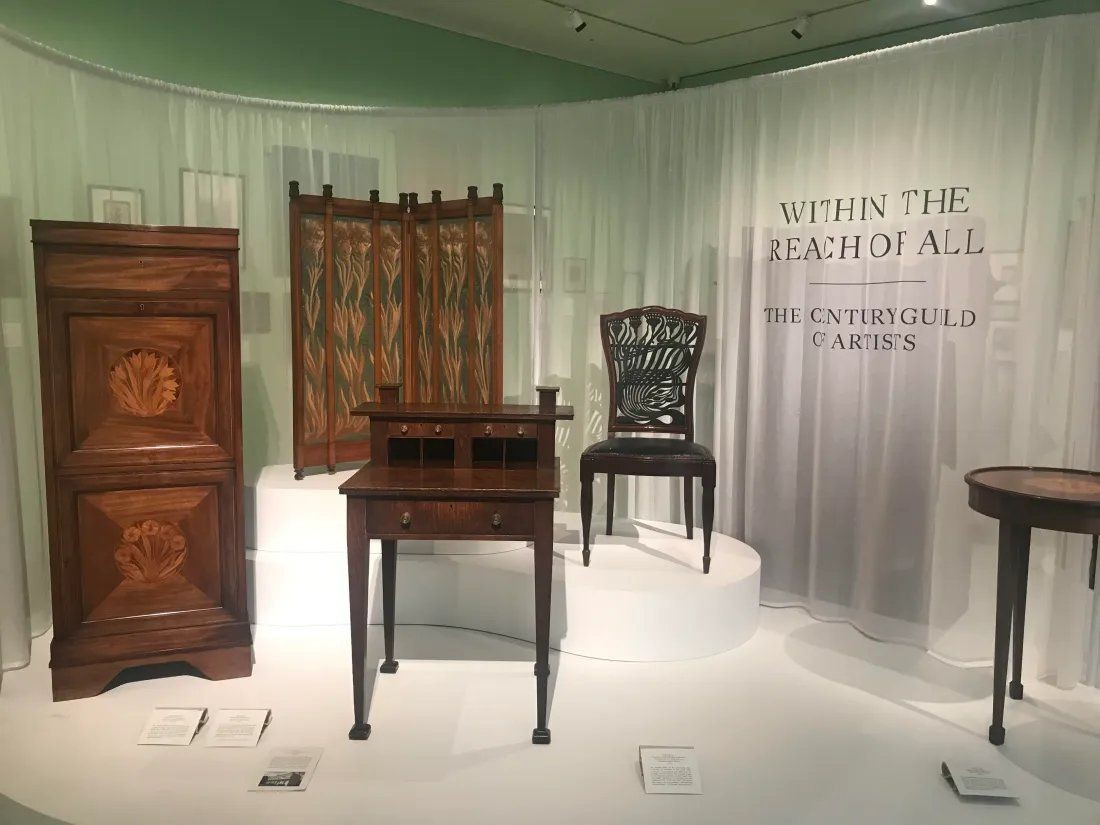
.jpg)
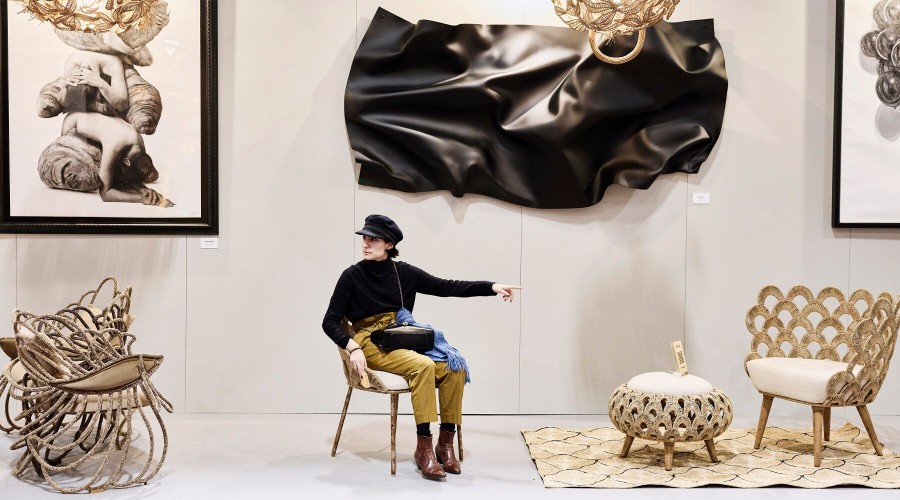

.jpeg)